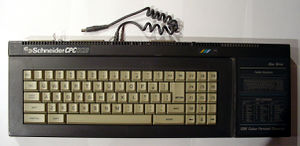Difference between revisions of "Schneider"
m |
|||
| Line 5: | Line 5: | ||
Although the original CPC contains DIP switches that allow the manufacturer to specify the OEM brand appearing on the boot screen of the computer, the Schneider CPCs had a few more differences from their UK and worldwide siblings: other than the german keyboard, they sported proper expansion ports and not mere PCB extensions. These were much more durable and they were implemented because of stricter german laws. Unfortunately this also meant that some [[peripherals]] would have a troubled time trying to connect to the back of the Schneider CPCs. | Although the original CPC contains DIP switches that allow the manufacturer to specify the OEM brand appearing on the boot screen of the computer, the Schneider CPCs had a few more differences from their UK and worldwide siblings: other than the german keyboard, they sported proper expansion ports and not mere PCB extensions. These were much more durable and they were implemented because of stricter german laws. Unfortunately this also meant that some [[peripherals]] would have a troubled time trying to connect to the back of the Schneider CPCs. | ||
| − | + | Until 1987 Schneider Computer Division also distributed the Amstrad PCW8256 (also known as Joyce), PCW8125 (Joyce Plus), PC1512 and PC1640. At the end of 1987 Schneider had distanced itself from Amstrad due to differences in dealership policies. So they started from 1987 an own production of computers, they build the EuroPC and EuroPCII (two very compact PC units on the same computer-in-a-keyboard format like the CPC6128), EuroXT and EuroAT. | |
Revision as of 16:28, 12 August 2006
Schneider Rundfunkwerke from Türkheim (Germany) manufactured (labeled) and sold the Schneider CPC 464, 664 and 6128 for the german market. In the middle 80s the Schneider Rundfunkwerke opened the Schneider Computer Division, where they sold the Amstrad Computers under license.
Although the original CPC contains DIP switches that allow the manufacturer to specify the OEM brand appearing on the boot screen of the computer, the Schneider CPCs had a few more differences from their UK and worldwide siblings: other than the german keyboard, they sported proper expansion ports and not mere PCB extensions. These were much more durable and they were implemented because of stricter german laws. Unfortunately this also meant that some peripherals would have a troubled time trying to connect to the back of the Schneider CPCs.
Until 1987 Schneider Computer Division also distributed the Amstrad PCW8256 (also known as Joyce), PCW8125 (Joyce Plus), PC1512 and PC1640. At the end of 1987 Schneider had distanced itself from Amstrad due to differences in dealership policies. So they started from 1987 an own production of computers, they build the EuroPC and EuroPCII (two very compact PC units on the same computer-in-a-keyboard format like the CPC6128), EuroXT and EuroAT.
